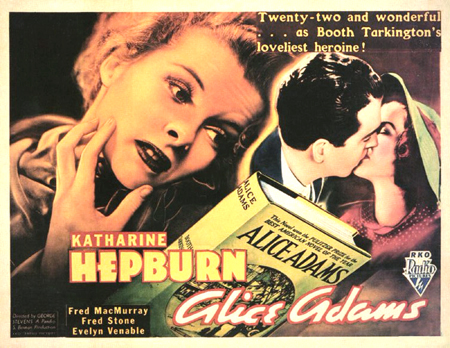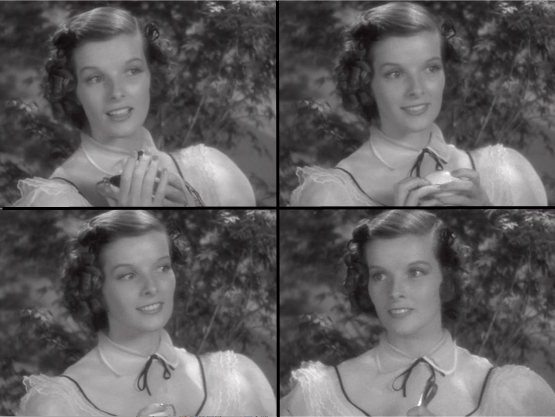Episode 8 of 52 wherein Anne Marie screens all of Katharine Hepburn's films in chronological order

I’ve spent a long time looking at photos of Kate for this blog. It’s not just that she’s beautiful. She just radiates confidence from every perfectly-posed angle. Sometimes, it’s hard to imagine that she could be touched by failure or anxiety. If she’s not relatable, she’s admirable. I’ve certainly idolized her. Earlier I worshipped Kate as Jo March, the success who tomboys aspire to be. But if Jo March - or Kate - is who young girls want to be, Alice Adams is who they so often feel like they are. And as such, Alice Adams is a shock for Hepburn fans...

Alice has no self-confidence. No self-image. No self-awareness. The story of a poor girl trying desperately to rise above her station sounds like a golddigging melodrama. But it’s not money that Alice covets; it’s acceptance. Kate embodies these insecurities in voice and physicality with painful realism.
The more histrionic Alice gets, the more vulnerabilities she lays bare. Nathaniel has already written about Kate’s chatter, so instead I’ll focus on those brief moments of quiet which speak just as loudly. Alice is too self-conscious to stay still. She constantly fidgets, attempting and failing to outrun her anxiety.
Her most active scene comes early, during a party. Alice has primped and prepared for the dance, but no suitors pursue her. Abandoned by her brother, Alice sits in the corner. She attempts to mask her humiliation through activity. Director George Stevens keeps the camera trained on Alice, as her rehearsed actions come to an end and she’s left exposed.

First Alice powders her nose with theatrical grace that belies many moments practicing in front of a mirror. Any supposed ease disappears when she looks around to see she hasn’t been noticed. She stiffens with a forced smile, but panic is in her eyes.

Alice next performs across two chairs. She stretches out over both in an attempt to look as though her beau has just left. Again, it’s all false bubbling gaiety.

But Alice is still alone and unnoticed, a fact which is hammered home a moment later when three men rush by her. Though framed in medium shot, Hepburn still manages to portray subtle, painful heartbreak through her eyes and the disappearing line of her mouth.

Kate excels in these moments when Alice is forced to drop her mask and acknowledge her loneliness. Alice is only noticed when she tries to toss her dead violet bouquet - the symbol of her disappointment - and instead has it returned to her by the handsome Arthur Russell (Fred MacMurray). She doesn’t realize that Russell is quite smitten with her, dead bouquet and all. Though Arthur pursues her, Alice continues to miss his obvious affection. After an intensely awkward dinner - the subject of Nathaniel’s post - Alice bids Arthur farewell, and only the magic of Hollywood keeps them together at the end.
Despite its ending, Alice Adams made me cringe in sympathy and sadness. It felt masochistic to watch a woman I idolized for her poise and defiance play a girl cowed and desperate for acceptance. Every girl at a dance has felt like Alice. Will I be noticed? Will I fit in? Am I pretty/interesting/lovable enough? Somehow, I held onto the fantasy that Kate found a way to transcend all of that crap.
Undeniably, by 1935 Kate had become a talented actress. Alice is not flawless - Kate couldn’t quite sell “blue collar.” Still, Alice Adams is Kate’s best dramatic role at RKO, as Oscar-worthy as any of her later wins. Too bad the Academy was too smitten with a certain doe-eyed fireball to notice.

Previous Weeks: A Bill of Divorcement, Christopher Strong, Morning Glory, Little Women, Spitfire, The Little Minister, Break of Hearts
Next: 2/24 Dangerous (1935): Part of the spinoff/competition Seasons of Bette.
2/27 Sylvia Scarlett (1935): In which Katharine Hepburn looks better in a suit than Cary Grant.